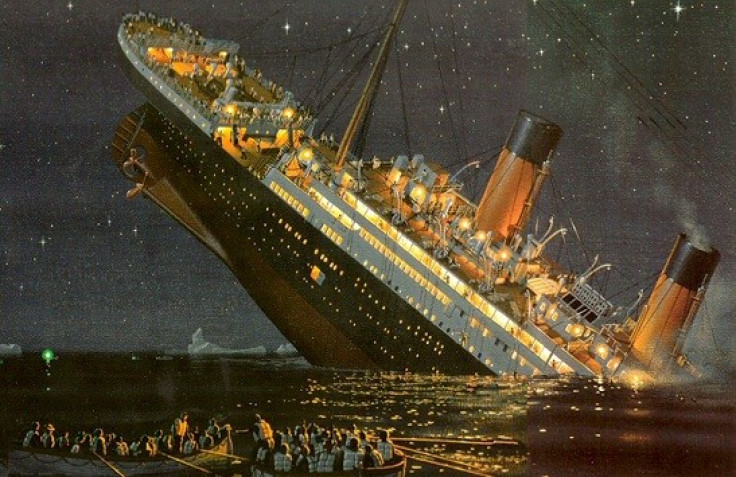Titanic 100th Anniversary: 5 Crazy Theories on the Historic Liner Disaster

This year marks the 100<sup>th anniversary of the RMS Titanic sinking in the Atlantic Ocean in the early hours of 15 April, killing more than 1,500 people. The acccepted explanation is it hit an iceberg - but many suspect more mysterious forces were at work.
The event is now regarded as one of the greatest tragedies of the 20<sup>th century and the occasion is being commemorated in a number of ways, including a ceremony in Southampton, where the ship set sail, and a release of James Cameron's blockbuster film Titanic in 3D - originally released in 2D.
With the Titanic receiving worldwide attention once again, it is, apparently, the perfect time for the conspiracy theories about the fate of the doomed vessel to reappear.
For some, the fact that the Titanic ran into an iceberg is too simple to be true, so they came up with their own ideas and suggestions as to what happened on that fateful night.
It Was a Mummy's Curse
One of the most well-known and unusual theories is the Titanic crashed into the iceberg because the ship was transporting an Egyptian mummy protected by an ancient curse.
Sources say the legend of the mummy's curse originated in the press, as it appeared in newspapers following the disaster.
According to the theory, the mythical case was on board the Titanic at the time of its voyage after having being bought by an American archaeologist from the British Museum, bringing the supposed 'curse' along with it.
The myth purports that the curse affected anyone who came into contact with the mummy while it was on display at the British Museum, either striking them ill or, even, causing death.
Unfortunately, there was no mummy on board the Titanic. Official records from the British Museum show that it never received the cursed mummy, only the lid of its sarcophagus, which is still on display today in the Egyptian room. Other than during wartime, when it was stored elsewhere for safe keeping, the lid has also never left the room.
The Titanic Never Sank
Although possibly not the most popular theory, there has been speculation that the Titanic never sank and that it was its sister ship, the Olympic, that actually went down.
Robert Gardiner put this theory forward in his book Titanic: The Ship That Never Sank?, where he suggests the owners switched ships for an insurance scam. Unfortunately, the ship ended up sinking instead of being rescued as originally planned.
Gardiner suggests swapping the vessels could easily have been done, since they were identical ships, except for a few minor changes and the ship's name on the lifeboats, life jackets, etc.
One of the flaws in this theory is that the task of switching the identities of two huge ships would have involved a lot of work and effort in terms of keeping people quiet. People have also pointed out the Titanic was grossly under-insured, so there would have been no financial gain in sinking it.
It Was Predicted in a Book
Perhaps more of coincidence than a theory, people have suggested the tragic events that befell the Titanic were foretold in Morgan Robertson's 1898 book, Futile, later renamed Wreck of the Titan.
The story in the book, published 14 years before the Titanic sank, has some similarities to the events as they unfolded: A large ship called Titan crashes into an iceberg on its maiden voyage in the north Atlantic; it set off in April; it hit the iceberg close to midnight (The Titanic reportedly hit its own iceberg at 11:40pm.); and the ship was 800ft long from bow to stern (Titanic was 882.5ft).
Reports that Robertson believed in the occult have added fuel to speculation that he had a vision. Then again, the similarities between the book and the sinking of the Titanic may have been a morbid fluke.
The Moon Sank The Titanic
Another theory that has only recently emerged in the run-up to the 100<sup>th anniversary of the Titanic concerns the Earth's proximity to the moon - the closest in 1,400 years - caused a high tide to occur in the Atlantic Ocean, which dislodged huge icebergs that floated into shipping lanes.
Unlike some other theories, this idea has some scientific reasoning behind it. The research was conducted by Dr Donald Olson, a Texas State University physicist, along with a team of forensic astronomers.
"The event 4 January was the closest approach of the moon to the Earth in more than 1,400 years, and it maximized the moon's tide-raising forces on Earth's oceans. That's remarkable," Olson said in the astronomy magazine Sky and Telescope.
"That could explain the abundant icebergs in the spring of 1912. We don't claim to know exactly where the Titanic iceberg was in January 1912 - nobody can know that - but this is a plausible scenario."
It Was a Mirage
A further theory to come out just before the anniversary of the ship sinking is that a rare weather condition created a 'mirage' which camouflaged the iceberg, preventing lookouts from seeing it until it was too late.
This theory comes from one of the biggest experts on the Titanic, British historian and author Tim Maltin. He has suggested that a mirage was created by a unique set of weather conditions, which caused an abnormal bending of light to occur, similar to the blur that can appear on a road on a warm day.
Matlin told the Daily Telegraph: "My research reconciles much previously unreconciled testimony and reveals that Titanic sank at the centre of a perfect storm of atmospheric conditions.
"It's nice to know that so many lives were not lost simply as a result of avoidable human mistake, but that it was a set of circumstances so peculiar that the crew were caught out."
© Copyright IBTimes 2024. All rights reserved.






